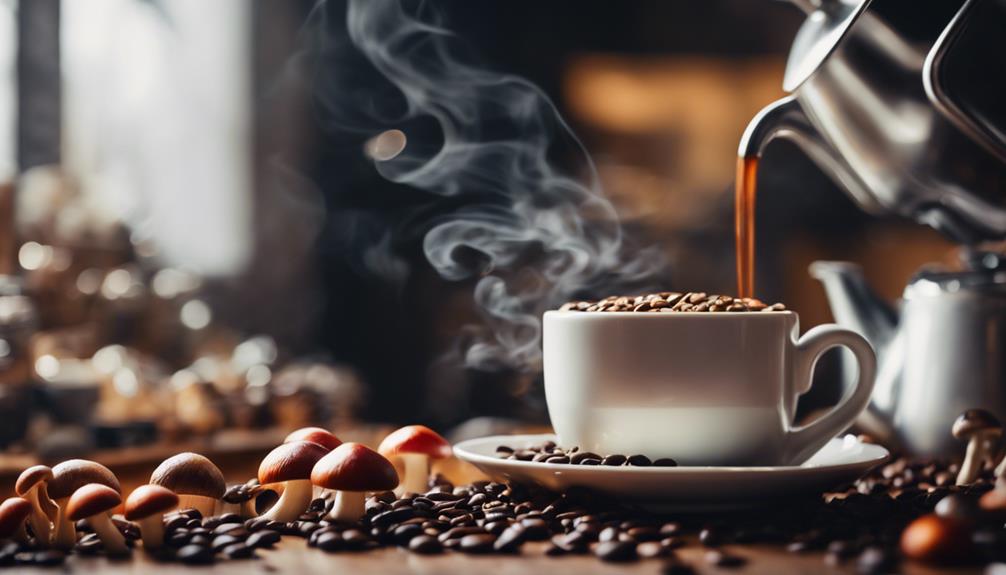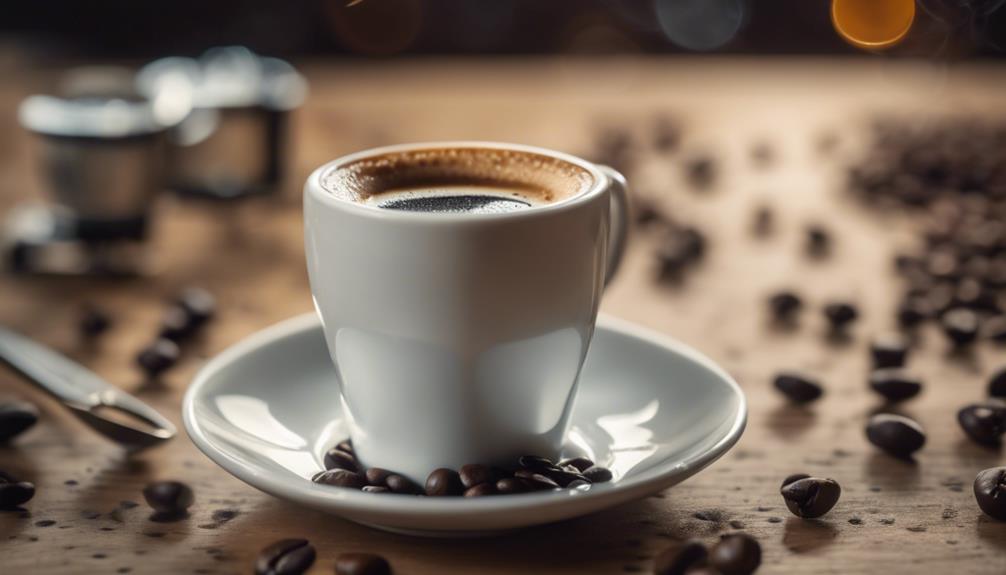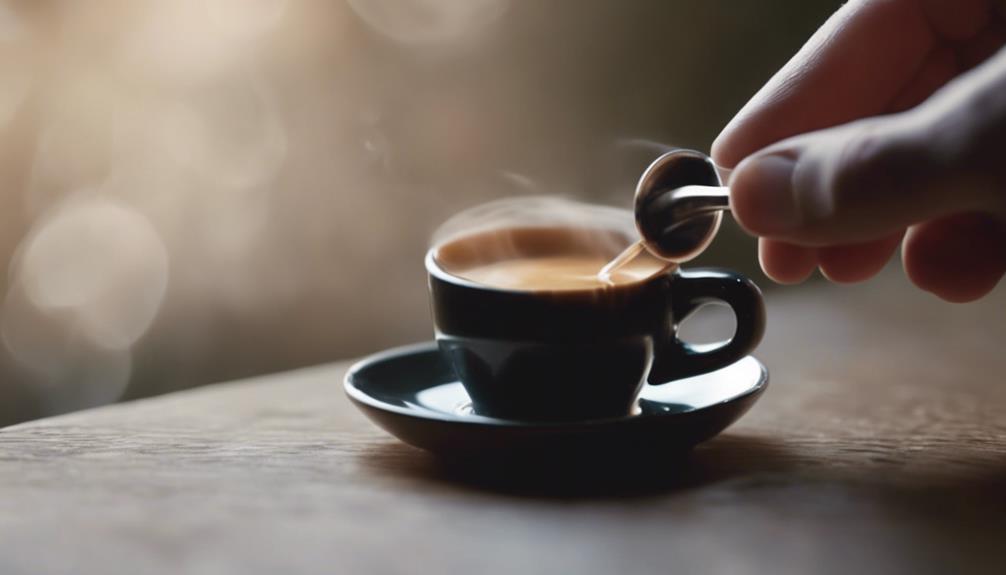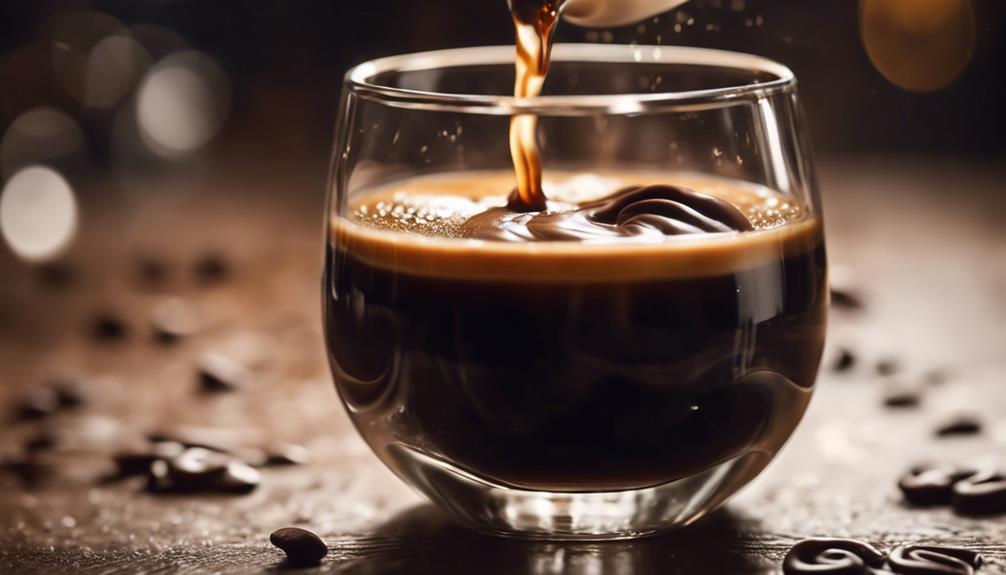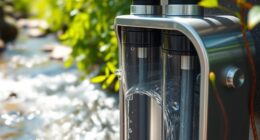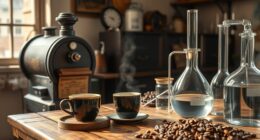Get ready to enter the world of espresso, where finely ground coffee beans are combined with high pressure to produce a rich flavor profile, smooth texture, and a unique sensory experience. Originally from Italy, espresso has become a worldwide sensation with its own brewing method, flavor profiles, and cultural importance. Espresso has a fascinating history separate from regular coffee, along with its own specialized tools and equipment. As you delve into the world of espresso, you will discover its intricacies, from different flavor profiles to brewing methods, and get a glimpse of the numerous variations that lie ahead.
Key Takeaways
- Espresso is brewed by forcing near-boiling water through finely ground coffee under high pressure, typically between 6 to 9 bars.
- A well-brewed espresso features a layer of crema, which enhances the balance of bitterness, acidity, and sweetness in the flavor profile.
- Espresso has a rich history that originated in Italy, with early machines playing a pivotal role in shaping modern brewing techniques and cultural significance.
- The ideal brew ratio is crucial for optimal flavor extraction, and factors like grind size, roast level, and brewing technique influence the final product.
Understanding Espresso Basics
Forcing near-boiling water through finely ground coffee under high pressure, you're fundamentally creating a complex flavor profile that defines espresso. This concentrated coffee is brewed in a unique way, resulting in a thick, creamy texture and a rich flavor experience.
When you take a shot of espresso, you're getting a dose of 60 to 100 mg of caffeine, depending on the coffee beans and brewing method used.
The brewing process involves pushing water through the coffee grounds at a pressure of 6 to 9 bars, which extracts the flavors and oils from the beans. The ideal brew ratio is essential to bring out the best flavor profile.
A well-brewed shot is characterized by a layer of crema on top, which enhances the overall flavor experience. The flavor profile of espresso is a delicate balance of bitterness, acidity, and sweetness, influenced by the type of beans, roast quality, and brewing technique.
Espresso History and Evolution
As you explore the world of espresso, you'll discover it has a rich history that spans centuries.
You'll learn about the early machines that paved the way for modern espresso, and how it evolved from its Italian roots to global popularity.
Let's take a closer look at the key milestones that shaped the espresso we recognize and love today.
Italian Roots
As you explore the world of espresso, you'll discover its rich Italian roots. In the late 19th century, Angelo Moriondo took the first step towards creating the modern espresso machine by submitting a patent for a device that could brew larger quantities of coffee. This marked the beginning of a journey that would shape the future of Italian coffee culture.
Fast-forward to 1906, Luigi Bezzera and Desidero Pavoni launched the first commercial espresso machine, producing shots that were quite different from the ones we understand today. Over the years, the espresso brewing method underwent significant changes, with machines evolving from steam-based systems to modern pressurized portafilters.
As a result, the popularity of espresso surged in Italy, eventually leading to a global demand for espresso and espresso-based drinks. Achille Gaggia played an essential role in refining the espresso process, contributing to its establishment as a cultural phenomenon in Italy.
Today, espresso is an integral part of Italian daily life, and its influence can be seen in coffee shops around the world.
Early Machines
You'll discover that the early espresso machines, patented by innovators like Angelo Moriondo and Luigi Bezzera, laid the groundwork for the modern brewing process.
Angelo Moriondo submitted the first espresso machine patent in 1884, designed to brew larger quantities of coffee quickly. Later, in 1906, Luigi Bezzera and Desiderio Pavoni created the first commercial espresso machine, considerably advancing the brewing process.
These early machines utilized steam pressure, resulting in a different espresso quality compared to modern machines that use consistent high pressure. The development of the portafilter system in the early 20th century allowed for better extraction and flavor in espresso.
As you explore the history of espresso, you'll notice how these pioneering machines paved the way for the rich espresso culture we enjoy today. The innovations in brewing technology have led to a considerable improvement in espresso quality, making it possible to savor a perfect shot of espresso with every brew.
Global Popularity
Discovering how espresso evolved from a local Italian phenomenon to a global sensation is a fascinating journey that reveals the drink's widespread appeal and versatility. As you explore the history of espresso, you'll notice a significant surge in its popularity over the last 50 years, leading to a global demand for espresso-based drinks and café culture.
| Espresso Milestones | Global Impact |
|---|---|
| 1884: First espresso machine patent | Introduction to quick coffee brewing |
| 1906: First commercial espresso machine | Widespread popularity in Italy begins |
| 1950s-60s: Espresso machines evolve | Global demand for espresso-based drinks grows |
| 1980s-90s: Coffee shop culture emerges | Espresso-based drinks become staples |
| 2000s: Modern espresso machines | Consistent quality and versatility in brewing methods |
Today, you can find espresso machines in coffee shops worldwide, brewing a variety of coffee drinks such as lattes, cappuccinos, and Americanos. The evolution of espresso machines has enabled consistent quality and versatility in brewing methods, meeting the global demand for this beloved beverage.
Espresso Vs. Coffee: Key Differences
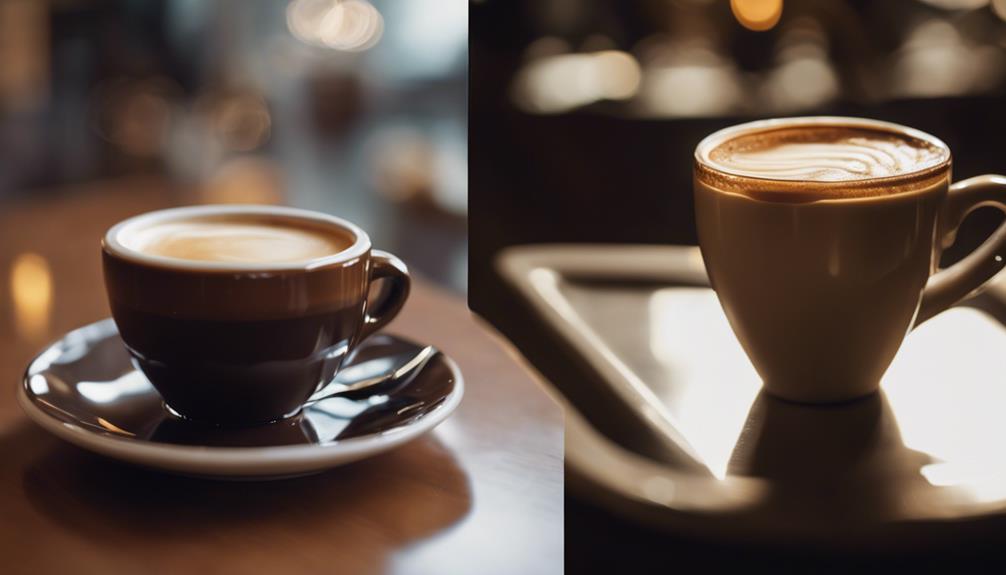
What sets espresso apart from regular coffee is the unique combination of high-pressure brewing, specialized roasting, and precise extraction that yields a distinct flavor profile and texture.
As you explore the world of espresso, you'll notice significant differences between it and regular coffee.
Here are the key differences:
- Brewing method: Espresso is brewed under high pressure (6-9 bars) using finely ground coffee beans, while regular coffee is brewed using gravity, resulting in a thicker and richer beverage.
- Caffeine content: A standard shot of espresso typically contains approximately 64 milligrams of caffeine, whereas an 8-ounce cup of regular coffee contains about 92 milligrams.
- Roast level: Espresso beans are usually darkly roasted for longer durations, enhancing oil extraction and bitterness, while regular coffee beans are often roasted for shorter times, resulting in lighter flavors.
These differences contribute to the distinct experience you get from enjoying a shot of espresso versus a cup of regular coffee.
Espresso Characteristics and Flavor
As you explore the world of espresso, you'll discover a complex flavor profile that's uniquely yours to experience.
You'll notice the rich, velvety crema and thick texture that sets espresso apart from brewed coffee.
Now, let's break down the key elements that make up this distinctive flavor, from the perfect balance of bitterness and acidity to the subtle nuances that elevate each shot.
Espresso Flavor Profile
You'll encounter a rich tapestry of flavors when you take a sip of espresso, with notes of bitter, sweet, acidic, and toasty goodness that'll tantalize your taste buds. The flavor profile of espresso is complex and influenced by various factors, including the type of coffee beans, roast quality, and brewing method.
Here are some key aspects that shape the flavor profile of espresso:
- Roast levels: Lighter roasts tend to be more acidic, while darker roasts yield a smoother, less acidic flavor.
- Coffee beans: The type and quality of coffee beans used can greatly impact the flavor profile of your espresso shot.
- Brewing method: The brewing method used can affect the extraction of flavors and oils from the coffee beans, resulting in a unique flavor profile.
With its complex flavor profile, espresso serves as a great base for various espresso drinks, allowing for diverse flavor combinations and experiences.
Crema and Texture
How does the velvety texture and rich aroma of crema, the signature crown of a perfectly brewed espresso, elevate your coffee experience? The crema is more than just a layer of foam on top of your coffee beverage – it's a sign of freshness and proper extraction. The quality and amount of crema can vary depending on the type of coffee beans used, with Arabica beans typically producing less crema than Robusta beans.
| Factor | Impact on Crema | Tips for Ideal Crema |
|---|---|---|
| Coffee Beans | Arabica: less crema, Robusta: more crema | Use freshly roasted beans for ideal crema |
| Grind Size | Incorrect grind size affects crema quality | Adjust grind size for ideal extraction |
| Freshness | Stale beans result in poor crema | Use beans roasted within two weeks prior to brewing |
A well-extracted espresso shot should have a thick, velvety crema that enhances the overall flavor experience. A lack of crema may suggest issues with grind size, tamping, or brewing technique. Achieving ideal crema requires attention to detail and a focus on using high-quality, fresh ingredients. By perfecting your brewing espresso technique and using the right coffee beans, you can experience the rich, velvety texture and aroma of crema in every brewed shot of espresso.
Bitterness and Acidity
Rich, bold flavors await you in a perfectly balanced espresso, where bitterness and acidity harmonize to create a complex taste experience. As you take a sip, the bitterness, resulting from the dark roasting process of the beans, hits your taste buds first. But don't worry, it's not overpowering – it's balanced by the acidity, which adds a bright and invigorating touch to the flavor.
Here's what you need to know about bitterness and acidity in espresso:
- Roast level matters: Lighter roasts tend to be more acidic, while darker roasts reduce acidity and emphasize bitterness.
- Grind size and brew temperature are essential: These factors influence the extraction of bitter and acidic compounds during brewing, affecting the final taste of your espresso.
- Crema plays a role: The brown foam on top of your espresso shot contributes to the perception of flavor, highlighting the drink's acidity and sweetness.
How to Enjoy and Prepare Espresso
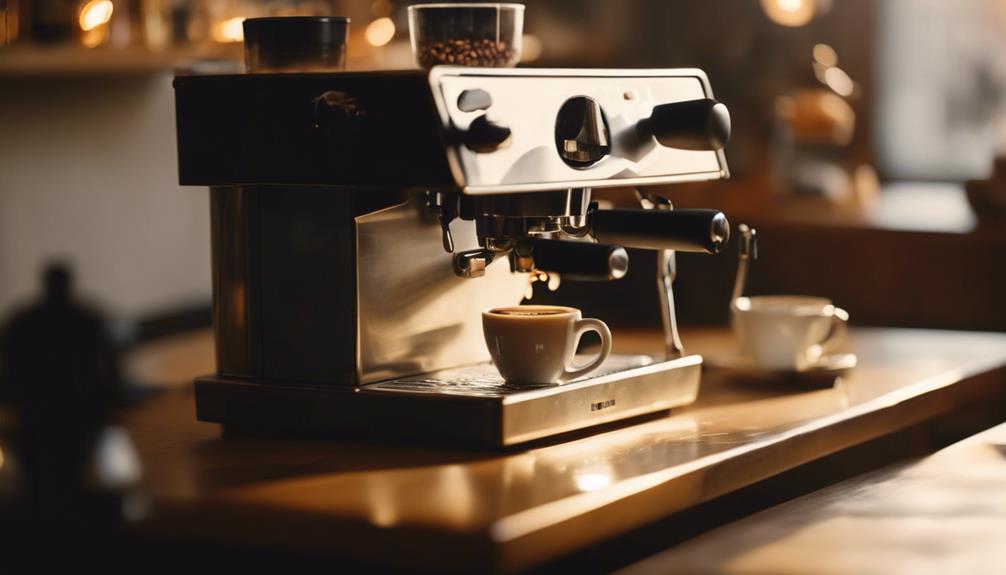
When it comes to preparing espresso, every detail counts, from the high-quality, freshly roasted coffee beans you start with to the precise brewing temperature that brings out the ideal flavor.
You'll want to grind those beans to a fine consistency, then secure them in a portafilter and tamp them evenly for uniform pressure.
As you brew, aim for a temperature between 194°F and 201°F and a brew time of 25-30 seconds for the best flavor profile.
When your espresso is topped with the perfect amount of crema, you'll know you've achieved a perfect cup.
To truly appreciate the complex flavors, sip your espresso slowly, noting the bitterness, acidity, and sweetness. Enjoy it with a side of cold or sparkling water to cleanse your palate between sips.
With the right tools, like a burr grinder, digital scale, and tamp mat, you'll be well on your way to making espresso like a pro.
Caffeine Content and Health Aspects
With every shot of espresso you drink, you're consuming a concentrated dose of caffeine that can have a significant impact on your body and daily routine. The amount of caffeine in a single shot can vary, but on average, you're getting around 75 mg per shot. This is a significant amount, considering the recommended daily limit is 400 mg for adults.
Here are some key points to keep in mind about caffeine content and health aspects of espresso:
One shot of espresso typically contains less caffeine than an 8-ounce cup of brewed coffee, but has a higher concentration per ounce.
Daily consumption of one shot is generally considered safe, but adding ingredients like milk or sugar can alter the caloric content and affect overall healthiness.
The type of coffee beans used to make espresso can impact the caffeine content, with darker roasts potentially having higher levels.
Espresso itself is very low in calories, with fewer than 5 calories per shot when served plain, making it a relatively healthy option when consumed in moderation.
Essential Barista Tools and Equipment
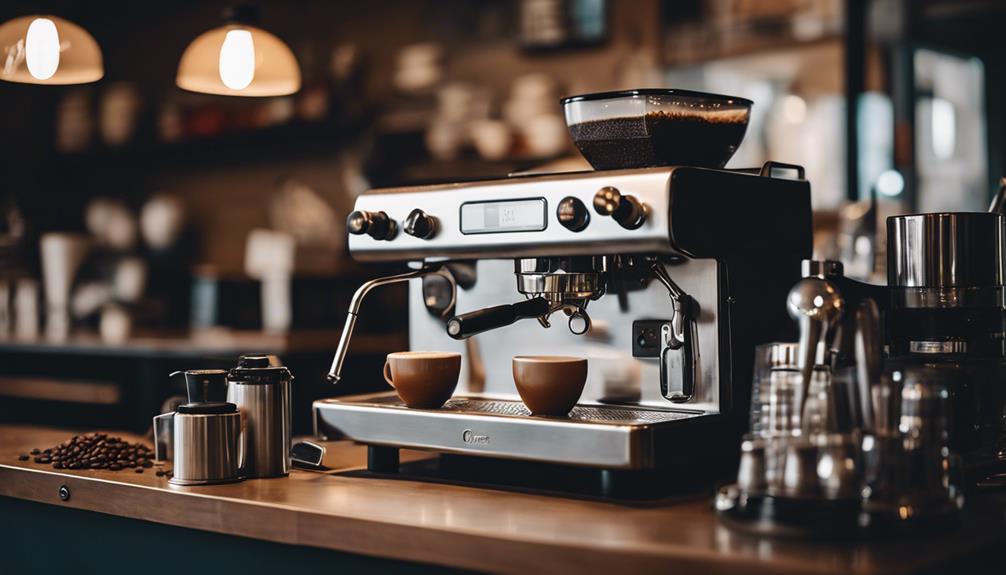
You'll need a range of specialized tools and equipment to craft exceptional espresso shots, and mastering their use is crucial to becoming a skilled barista. From precision measurement to efficient cleanup, each tool plays a critical role in the espresso brewing process.
| Tool | Function | Importance |
|---|---|---|
| Portafilter | Holds coffee grounds during extraction | Vital for perfect shots |
| Digital Scale | Measures coffee and water accurately | Maintains consistency in brewing ratios |
| Tamper | Compresses coffee grounds into a puck shape | Promotes even extraction and enhances flavor |
| Tamper Mat/Stand | Provides stability while tamping | Prevents movement and guarantees a level coffee bed |
With these tools at your disposal, you'll be well on your way to creating rich, velvety espresso shots. The knock box, for instance, allows you to easily dispose of spent coffee grounds, guaranteeing a clean and efficient workspace. By mastering the use of each tool, you'll be able to experiment with different brewing ratios and techniques to find your perfect cup. Remember, the key to exceptional espresso is attention to detail, and the right tools can make all the difference.
Popular Espresso-Based Drinks
Now that you've mastered the art of crafting exceptional espresso shots, it's time to explore the various drinks you can create using this concentrated coffee as a base. You can drink espresso on its own, savoring the bold, rich flavors, or use it as a base for other delicious drinks.
Here are some popular espresso-based drinks you might enjoy:
- Americano: Combine a shot of espresso with hot water to create a drink that's similar to brewed coffee.
- Latte: Top a shot of espresso with steamed milk and add your favorite flavors for a creamy, sweet treat.
- Cappuccino: Balance equal parts espresso, steamed milk, and foamed milk for a rich, layered drink.
These drinks showcase the versatility of espresso and offer a range of flavors and textures to suit any taste.
Whether you prefer your espresso straight up or mixed with milk and flavorings, there's a drink out there for you.
Buying and Storing Espresso Beans
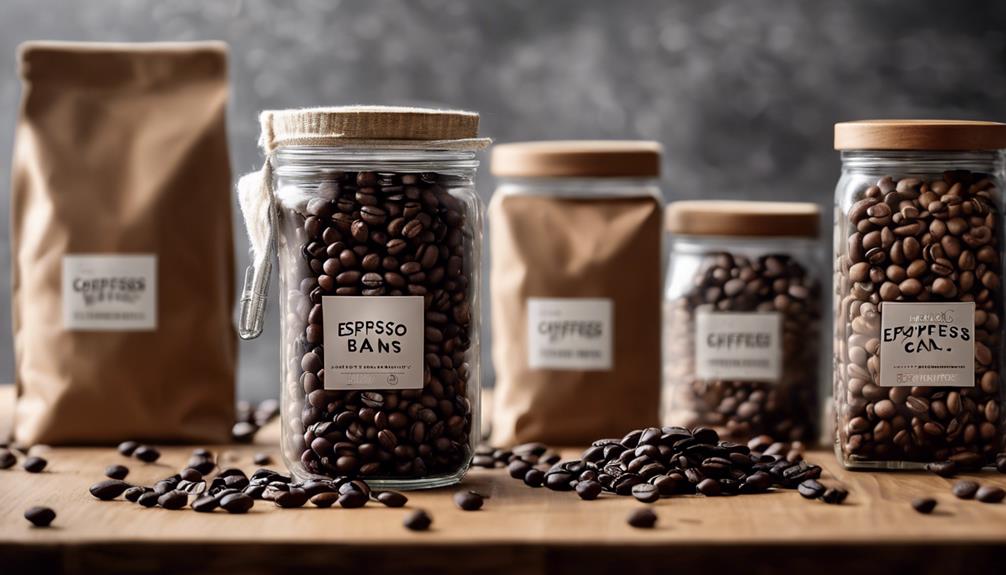
Selecting the right espresso beans is essential to achieving ideal flavor and crema production in your espresso shots. When buying espresso beans, choose freshly roasted ones within two weeks of the roast date to guarantee the best flavor and crema production. Look for beans specifically labeled for espresso, as they're typically roasted darker to enhance oil release and flavor extraction.
To preserve the freshness of your espresso beans, store them in an airtight container in a cool, dark place. This will prevent oxidation and maintain the beans' flavor quality. Avoid refrigerating or freezing your espresso beans, as temperature fluctuations can lead to moisture buildup and affect flavor quality.
Grind your espresso beans just before brewing to maintain the integrity of the flavors and guarantee the best crema. By following these simple tips, you'll be able to extract the perfect shot of espresso every time.
Frequently Asked Questions
What Is the Basic Knowledge of Espresso?
You want to know the basics of espresso? It's a concentrated coffee made by forcing hot water through finely ground coffee at high pressure, resulting in a rich, complex flavor profile with a thick crema layer. If you’re interested in making espresso at home, there are several options available. One popular choice is the Flair Espresso Maker, which has received positive reviews from many coffee enthusiasts. If you’re considering purchasing one, you may want to read a flair espresso maker review to see if it meets your needs and expectations. This manual espresso maker allows you to control the brewing process and produce a high-quality espresso with a deep, satisfying flavor.
What Are the 4 Qualities of Espresso?
As you lift the demitasse, a velvet curtain of crema parts, revealing the four main qualities of espresso: a rich body, a flavorful heart, a complex flavor profile, and, of course, that crowning glory of crema.
What Are the Golden Rules of Espresso?
You're wondering about the golden rules of espresso, right? Well, to get it just right, you'll want to use fresh beans, a consistent grind, ideal brewing temp, proper pressure, and a precise timing.
What Are 3 Essential Requirements for a Coffee to Be an Espresso?
As you explore the world of espresso, you'll find three essential requirements: you need finely ground coffee beans, hot water brewing under 6-9 bars of pressure, and a precise extraction time of 25-30 seconds to craft the perfect shot.
Conclusion
As you've explored the world of espresso, you've likely discovered it's not just a drink, but an experience.
Like a maestro conducting an orchestra, a skilled barista harmonizes flavors and textures to create a masterpiece.
Just as a single note can elevate or ruin a symphony, a single misstep can ruin an espresso shot.
Now, go forth and appreciate the nuances of this beloved brew, and remember, the perfect shot is just a note away.

